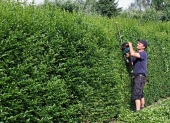Your biggest problem is the desire for this to an evergreen hedge. You didn't mention how much sunlight the space receives so I'll assume there is at least 6 hours of sun.
Good shrubs to grow as hedges: blueberry, bush plum, currant, gooseberry, hazelbert, natal plum, American cranberry bush, and the pineapple guava.
Some good edible shrubs to grow as a barrier: brambles (Blackberry and Raspberry), gooseberry, natal plum, and Rugosa rose.
here are the descriptions from the National Gardening Association
All shrubs below are deciduous and grow best in full sun and on well-drained soil unless otherwise stated.
• American Cranberry bush (Viburnum trilobum) - This 6- to 10-foot- tall shrub is hardy in zones 3 to 8.
It produces white flowers in spring and bright red fruits in late summer.
The fruits are good in jams and they are an excellent wildlife food.
This sprawling shrub is best used as an informal hedge.
•Blueberry (Vaccinium) - Select varieties that are highbush (5 to 6 feet tall) or half-high (1 to 4 feet tall) depending on your location.
Southern and rabbiteye blueberries are highbush types adapted to the South.
Blueberries need a well-drained, acidic soil with the pH below 5. Add sulfur to lower the pH.
They can be planted near other acid-loving shrubs, such as holly. They are hardy in zones 3 to 9.
•Brambles (Rubus) - Hardy in zones 3 to 9, blackberries and raspberries make excellent barrier shrubs.
They can also be trained to grow along a fence in a narrow bed since their growth habit is so vertical.
Select spreading brambles, such as red raspberries and blackberries, as an informal barrier hedge.
Their suckers will quickly fill in the blank areas.
For a more contained barrier hedge, plant black raspberries that send up suckers from only around the crown of the plant and are less invasive.
For fruit production in summer and fall, grow everbearing red raspberries such as 'Heritage'.
•Bush Plums (Prunus) - Sometimes called cherry-plums, Nanking cherries,(sand cherries), small-fruited shrubs grow about 6 to 10 feet tall, have showy white flowers and 1/2-inch-diameter tart fruits they are hardy in zones 3 to 9 depending on the species.
The fruits are best used in jams and jellies. Sand cherries make good coastal plants because of their adaptation to salt spray and sandy soil.
•Currants and Gooseberries (Ribes) - White, red, and black currants make excellent foundation plants, and can be grouped to block an unsightly object, or grown into informal hedges.
Hardy in zones 3 to 8, most grow to 5 feet tall and have attractive and delicious fruits.
Red and white currants are best used as juices and for fresh eating, while black currants are best used in jams and preserves.
Black currants are the alternate host to a deadly disease of white pines (blister rust).
So if you have white pines growing near your property, grow disease-resistant black currant varieties such as 'Consort'.
Gooseberries grow to 3 to 4 feet tall and have thorny branches.
They produce tasty 1-inch-long fruits for fresh eating, pies and jams.
•Hazelbert (Corylus) - A cross between a filbert and a hazelnut, this 8- to 12-foot-tall shrub is hardy, has beautiful fall foliage, and produces edible nuts. It makes an excellent edible hedge.
•Natal Plum (Carissa grandiflora) - This tropical evergreen shrub is only hardy in zones 9 to 11.
It grows to 6 to 10 feet tall with fragrant, white flowers and edible red fruits.
The plum-shaped fruits taste like cranberries and can be used to make jam.
This is another good seaside plant. It makes an excellent foundation plant or hedge.
•Pineapple Guava (Feijoa sellowiana) - This large, evergreen, tropical, shrub grows to 15 feet tall and wide in zones 8 to 10. It produces edible, pear-shaped fruits with a pineapple- and strawberry-like flavor. These are best used as informal hedges.
•Rosemary (Rosmarinus officinalis) - This evergreen shrub is hardy in zones 9 to 11 and makes an excellent low hedge or border plant. The fragrant leaves are essential in many culinary dishes.
•Rugosa Rose (Rosa rugosa) - This species rose is hardy in zones 3 to 9, and can grow to 8 feet tall.
It produces edible, fragrant, white, pink, or red flowers in spring and red or orange rose hips in late summer.
The hips are high in vitamin C and best eaten raw, in teas or in jams.
The thorny branches make it an excellent barrier plant, especially since new shoots arise from root suckers. This is another good seaside plant.
For more ideas try the website of the National Gardening Association
NGA
Redhawk






 1
1

































 2
2




 1
1












